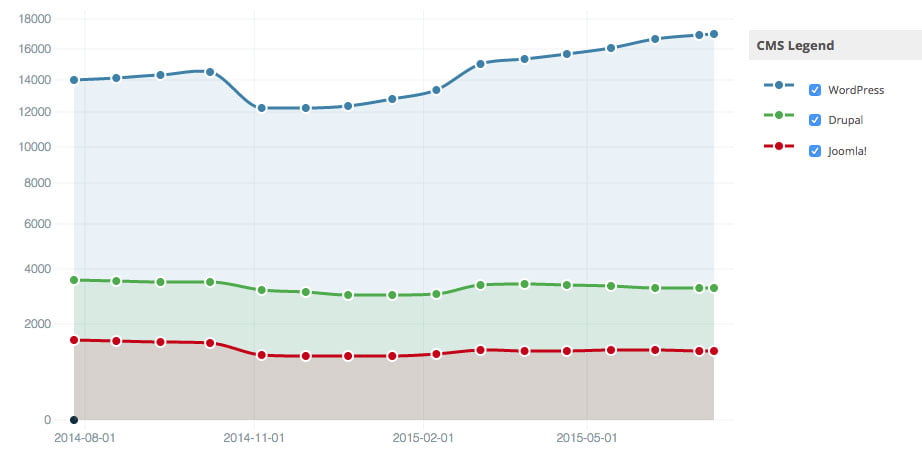WordPress, Joomla and Drupal dominate the content management system (CMS) market share. Designers and front-end users swear by WordPress, while programmers and geeks drool over Drupal. Joomla meets everybody somewhere in the middle, but also has its share of pros and cons.
All CMS comparisons online seem to target either designers or developers as their audience, so if you would like to read about theming, extensions or nitty-gritty technobabble, you’re in the wrong place. If you’re a business owner (or seeking to get a website built in general) and want to know the best possible content management system for your business or personal goals, read on.
Effectiveness in Meeting Requirements
For most small-medium businesses, our top choice is WordPress.
For most large businesses, our top choice is Drupal.
Each content management system has its own unique way of handling website functions. Some content management system choices are obvious for certain things, like if your focal point is blogging, WP is the clear winner straight out of the box. If you have a larger budget, need high security, advanced features and ultra customized functionality, Drupal is the answer. After all, NASA and the Whitehouse did not just use Drupal for its pretty little dewdrop logo and its vibrant geek community. If you want a lot of features and functionality combined with decent customizability at the best price, Joomla is your clear choice.
** Update: From the time of initially writing this post, Joomla taken a bit of a back seat as most functions are now easily overtaken by WordPress. It will be exciting to see the competition among the leading content management systems in the near future. It is also important to keep in mind that technologies come and go rapidly. Your content should be the prime focus, while the 'container' of this content should be fluid, easy to update and responsive to technological changes.
Back-end customization (for the programmer)
WordPress
Back-end CustomizationDrupal
Back-end CustomizationJoomla
Back-end CustomizationAlthough this post is directed at the business owner, it’s important to at least know the extent and limitations of back-end capabilities so you don’t experience surprise costs or limitations in the future. Drupal is the best content management system for most development / coding work because it has the most flexible underlying framework. In other words, if you want to make changes to the structure of your website, and really customize the functionality and positions of “things” (mainly modules and add-ons) – Drupal is your best choice, but pricy. Drupal also handles high volume traffic beautifully.
WordPress has improved significantly in the past few years, and even beat Joomla in terms of popularity. Although WordPress has a slightly more rigid framework, many developers feel that Joomla has gotten very clunky and filled with useless "junk" in comparison, forcing responsible developers to work hard at clean-up, speed optimization, and eliminating duplicate content issues. Not that WordPress doesn't have these issues, it does, but to a much lesser degree, especially in 2015.
Remember, popular does not equal better, but WordPress is most often the best choice for small - medium businesses, especially those that don’t require very heavy website customization and want a cost-effective, yet powerful solution.
Front-end customization (for the designer & content manager)
WordPress
Front-end customizationDrupal
Front-end customizationJoomla
Front-end customizationWordPress is the winner hands-down for front-end technical work; this is what makes it so popular. Are you afraid of too much code? WordPress is brilliant for those who are artistically gifted, technically handicapped, or those who just want a quick, simple and cost-effective out-of-the-box solution. WordPress has a ton of front-end website-builder-type features that can make website maintenance easier and more cost-effective - from swapping the logo to changing font styles to setting up the blog area – you can do most of it with minimal programming work, or simple pay a lot less for your webmaster to do it for you.
However, all these benefits come at a price: WordPress tends to get buggy, complex and expensive when it comes time to step outside the box. Do you want to suddenly insert a webform into your sliding banner and keep everything responsive? Sure, you can accomplish this in WP… but the costs can easily escalate if you decide to create an atypical layout, design or function that involves stepping outside the framework of the theme or CMS. Just be aware that front-end freedom often coincides with back-end limitations.
Drupal is by no means exempt from high customization costs - but the difference is, most Drupal clients are expecting it. WP and Joomla can be very cost-effective when you stay within the boundaries of the framework, so when you eventually want to make a seemingly simple change, the estimate may come as a shock.
Content management (for the client)
WordPress
Content managementDrupal
Content managementJoomla
Content managementFront-end content management is important if you want active control over your own web content, and you or your staff is regularly updating web pages or blogging.
Even if you opt for WordPress, the most client-friendly of the bunch, some technical know-how is required, especially with the recent switch to HTML5 and responsive web design.
Joomla has add-on editors that can be integrated quickly and easily to make content management simple for the client.
As of writing this post, Drupal does not yet have a good front-end wysiwyg (what-you-see-is-what-you-get) editor that accommodates HTML5 and responsive elements.
Search Engine Optimization (out-of-the-box)
WordPress
SEODrupal
SEOJoomla
SEOThere’s no question that all content management systems need some extra work or add-on SEO modules to maximize their SEO capabilities. Drupal has the most SEO-friendly architecture straight out of the box. Joomla and WordPress require some add-on SEO extensions and plugins to compete on the same SEO level as Drupal.
Joomla requires the most initial care and attention in terms of SEO, but it has the potential to rank very high if your developer sets up your website and pages properly. Add a solid SEO extension while eliminating all forms of duplicate content, and you’re golden.
WordPress has made amazing strides in SEO capabilities. Not only does it have powerful plug-ins that can be quickly integrated, but the fact that it's built for blogging makes SEO easy breezy.
CMS Usage Statistics
TOP 100,000 WEBSITES




